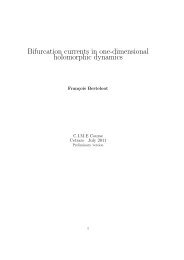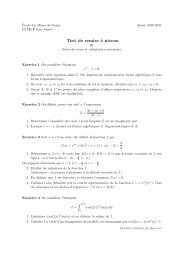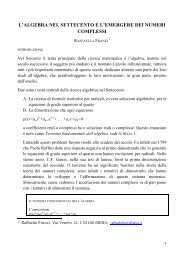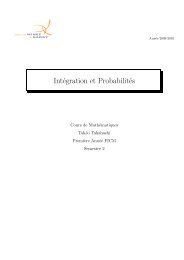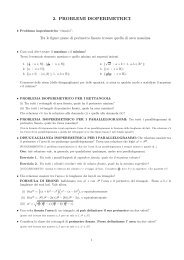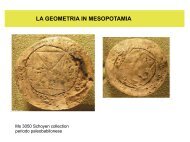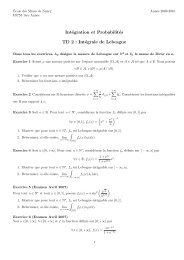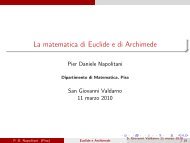Derivation of a fundamental diagram for urban traffic flow
Derivation of a fundamental diagram for urban traffic flow
Derivation of a fundamental diagram for urban traffic flow
Create successful ePaper yourself
Turn your PDF publications into a flip-book with our unique Google optimized e-Paper software.
4 The European Physical Journal B<br />
(1 − f i )/(1 − u i ) ≤ 1 <strong>of</strong> vehicles is delayed, together with<br />
equations (15) and(20) we find<br />
Fig. 2. Schematic illustration <strong>of</strong> vehicle trajectories and signal<br />
operation in the case f i = u i, where there are no excess green<br />
times so that the <strong>traffic</strong> light is turned red as soon as the vehicle<br />
queue has been fully resolved.<br />
Hence, the percentage <strong>of</strong> delayed vehicles is<br />
A i [T cyc − (ΔT i − T i )]<br />
A i T cyc<br />
=1− f i − u i<br />
1 − u i<br />
= 1 − f i<br />
1 − u i<br />
≤ 1. (19)<br />
Altogether, the average delay <strong>of</strong> all vehicles is expected<br />
to be<br />
T av<br />
i (u i , {f j })= (1 − f i)<br />
(1 − u i )<br />
Inserting equation (5) gives<br />
T max<br />
i ({f j })<br />
2<br />
= (1 − f i) 2 T cyc ({f j })<br />
. (20)<br />
1 − u i 2<br />
Ti av (u i , {f j })= (1 − f i) 2 T los<br />
(1 − u i ) 2(1 − ∑ j f j) , (21)<br />
while with equation (15) weobtain<br />
Ti<br />
av (u i , {f j })= 1 − f i ΔNi max (u i , {f j })<br />
. (22)<br />
1 − u i 2u i ̂Q i<br />
There<strong>for</strong>e, the average delay time is proportional to the<br />
maximum queue length ΔNi<br />
max , but the prefactor depends<br />
on f i = (1 + δ i )u i (or the safety factor δ i , respectively).<br />
In case <strong>of</strong> no excess green time (δ i =0and<br />
f i = u i ), we just have<br />
Ti av ({u j })=(1− u i ) T cyc({u j })<br />
=<br />
2<br />
=<br />
ΔN<br />
max<br />
i ({u j })<br />
2A i<br />
ΔN<br />
max<br />
i ({u j })<br />
2u i ̂Qi<br />
(23)<br />
(see Fig. 2).<br />
Similarly to the average travel time, we may determine<br />
the average queue length. As the average number<br />
<strong>of</strong> delayed vehicles is (ΔNi<br />
max +0)/2 andafraction<br />
ΔN av<br />
i (u i , {f j })= (1 − f i)<br />
(1 − u i )<br />
ΔN max<br />
i (u i , {f j })<br />
2<br />
(1 − f i ) 2 T cyc ({f j })<br />
= u i ̂Qi<br />
(1 − u i ) 2<br />
= u i ̂Qi Ti av (u i , {f j }). (24)<br />
This remarkably simple relationship is known in queuing<br />
theory as Little’s Law [39], which holds <strong>for</strong> time-averaged<br />
variables even in the case <strong>of</strong> non-uni<strong>for</strong>m arrivals, if the<br />
system behaves stable (i.e. the queue length is not systematically<br />
growing or shrinking). It also allows one to establish<br />
a direct relationship between the “average vehicle<br />
density”<br />
ρ av<br />
av<br />
ΔNi<br />
i = (25)<br />
L i<br />
on the road section used by stream i and the utilization<br />
u i = A i / ̂Q i ,namely<br />
ρ av<br />
i = u i ̂Q i Ti<br />
av<br />
. (26)<br />
L i<br />
Note that the average density ρ av<br />
i has the same dependencies<br />
on other variables as ΔNi<br />
av or Ti<br />
av , and an additional<br />
dependency on L i , i.e. the more natural quantity to use is<br />
the queue length ΔNi av .<br />
2.1 Efficiency <strong>of</strong> <strong>traffic</strong> operation<br />
In reality, the average delay time will depend on the timedependence<br />
<strong>of</strong> the in<strong>flow</strong> A i (t),andonhowwellthe<strong>traffic</strong><br />
light is coordinated with the arrival <strong>of</strong> vehicle platoons. In<br />
particular, this implies a dependence on the signal <strong>of</strong>fsets.<br />
In the best case, the average delay is zero, but in the worst<br />
case, it may also be larger than<br />
1 − u i<br />
T cyc ({u j })= (1 − u i)T los<br />
2<br />
2(1 − ∑ j u j) , (27)<br />
see equation (20) withf i = u i . We may, there<strong>for</strong>e, introduce<br />
an efficiency coefficient ɛ i by the definition<br />
Ti<br />
av ({u j },ɛ i )=(1− ɛ i ) (1 − u i)T los<br />
2(1 − ∑ j u j)<br />
or, considering equation (24), equivalently by<br />
(28)<br />
ΔNi<br />
av<br />
(1 − u i )T los<br />
({u j },ɛ i )=(1− ɛ i )u i ̂Qi<br />
2(1 − ∑ j u j) . (29)<br />
For ɛ i = 1, the <strong>traffic</strong> light is perfectly synchronized with<br />
platoons in <strong>traffic</strong> stream i, i.e. vehicles are served without<br />
any delay, while <strong>for</strong> ɛ i = 0, the delay corresponds to<br />
uni<strong>for</strong>m arrivals <strong>of</strong> vehicles, when no excess green time<br />
is given. If the <strong>traffic</strong> light is not well synchronized with<br />
the arrival <strong>of</strong> vehicle platoons, we may even have ɛ i < 0.



